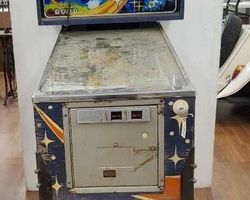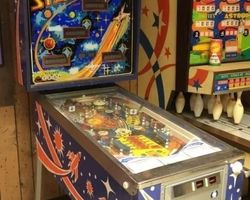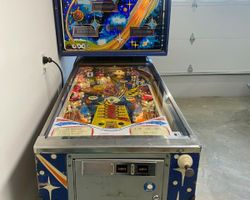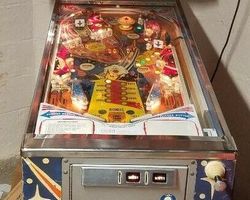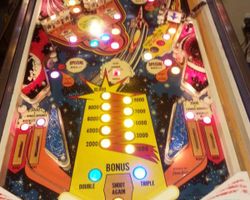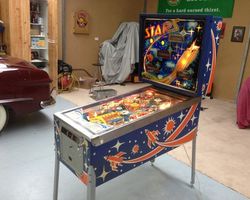Stars
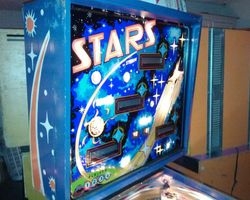
Average Prices: USD $100 to $1,600
Produced: March, 1978
Production Run: 5,127 units
Machine Type: Solid State Electronic
MPU: Stern M-100 MPU
Players: 4
Design by: Steve Kirk
Art by: Jorge Obregon
"Stars" by Stern Electronics, Inc., launched in March 1978, emerged during a pivotal era for pinball. The industry was actively transitioning from electromechanical (EM) machines to solid-state (SS) technology, and Stern, founded by Gary Stern, played a role in this shift. "Stars" was an early example of Stern's solid-state offerings, showcasing the capabilities of the Stern M-100 MPU system. The game's theme, generic space exploration, provided a canvas for captivating artwork and simple yet engaging gameplay.
The design of "Stars" was spearheaded by Steve Kirk, known for his ability to craft playfields that offered both accessibility and depth. Jorge Obregon contributed the distinct artwork, rendering a cosmic backdrop for the machine's interactive elements. Notably, "Stars" holds a unique position in pinball history for several design quirks. It was one of two four-player games from Stern that could be converted to two-player operation via a CPU switch setting, catering to specific market demands. This adaptability even extended to a special two-player backglass for these configurations. A signature feature attributed to Steve Kirk himself is the "Kirk Post," a small post positioned between the flippers, a design element that would later appear in various forms across other pinball titles. Kirk even subtly incorporated his personal design number, SK-1, onto the backglass art of "Stars," a practice he continued on subsequent designs. With 5,127 units produced between March and June 1978, "Stars" achieved a significant production run for its time, solidifying its presence in the burgeoning solid-state market. A distinctive characteristic of this early solid-state machine is its reliance on chimes for audio, rather than a dedicated sound board, offering a nostalgic auditory experience reminiscent of its electromechanical predecessors.
Signature Features and Design
"Stars" distinguishes itself with a clean and direct playfield design, emphasizing fundamental pinball mechanics over elaborate toys. The singular pop bumper, a central element, provides a surprising amount of kinetic action, propelling the ball into unpredictable trajectories across the upper playfield. Complementing this is a pair of slingshots that energize side-to-side movement. The machine’s primary interactive targets include five standup targets arranged in star shapes and two sets of three-bank drop targets, strategically placed to encourage precision shooting.
The most discussed and defining feature is the "Kirk Post," a mini-post screw positioned directly between the two main flippers. While some players perceive it as an obstacle leading to frustrating drains, many recognize it as a design choice that enhances skill development and adds a layer of challenge. It forces players to hone their flipper control and nudging techniques, turning what might be a straightforward center drain on other machines into a moment of potential recovery or strategic deflection. Two spinning targets, or spinners, are also prominent, particularly the right-side spinner which becomes a high-value shot when the game's "stars" are lit. These spinners provide gratifying feedback, rewarding well-aimed shots with rapid rotations and point accumulation. The interaction of these elements — the pop bumper feeding the central playfield, the drop targets requiring accuracy, and the spinners offering rewarding risk-reward shots — forms the core of "Stars'" appeal, demonstrating how seemingly simple features can create engaging gameplay.
Playfield and Mechanics
The "Stars" playfield presents an open yet challenging layout, designed for direct shot-making. The lower playfield is dominated by the two flippers, separated by the aforementioned "Kirk Post," leading into the main outlanes and a center drain. Above the flippers, two sets of three-bank drop targets are positioned, one on each side, providing clear objectives for players. To the left, a bank of three drop targets governs bonus multipliers, while the right bank activates the left spinner. Five standup star targets are scattered across the playfield, encouraging wide-ranging shots and adding to the visual theme. These targets are critical for lighting the star display at the top of the playfield, which in turn enhances the value of the right spinner and activates the "roving special."
The playfield's overall flow is geared towards skillful target completion and spinner ripping. Shots up the left side typically feed the left drop targets or a lane leading to the top, while shots to the right aim for the right drop targets and the high-scoring right spinner lane. The single pop bumper is positioned centrally in the upper playfield, ensuring that balls reaching that area are often unpredictably fed back into the main play area, setting up further shot opportunities or defensive plays. Visually, Jorge Obregon's artwork captures a quintessential late-70s space aesthetic. The playfield itself is adorned with celestial bodies, starbursts, and cosmic elements, while the backglass depicts a more abstract, futuristic scene. The lighting is straightforward, illuminating targets and score displays without complex animations, consistent with early solid-state design. The reliance on physical chimes for sound provides a distinct auditory experience, with crisp, mechanical tones signaling score increments, bonus awards, and specials, contributing to the machine’s classic appeal.
Gameplay Dynamics
The gameplay of "Stars" is defined by its straightforward ruleset and surprising depth, making it accessible for new players while offering enduring challenge for experienced enthusiasts. The primary objective revolves around activating the "roving special" and maximizing score through two distinct, yet often intertwined, strategies. One strategy centers on lighting all five "stars" scattered across the playfield. Success in this endeavor boosts the value of the right spinner, transforming it into a high-scoring target, and crucially, activates the "roving special" at the top of the playfield. The "roving special" moves between designated lanes, requiring precise timing and accurate shots to collect its substantial points.
The alternative, or complementary, strategy involves systematically dropping the two banks of three drop targets. Dropping the left bank increases the bonus multiplier, which is applied to the end-of-ball bonus accumulated from various playfield features. The right bank of drop targets, once cleared, energizes the left spinner, making it a lucrative shot. Players often develop a rhythm of alternating between these objectives, assessing the current state of the playfield to determine the most advantageous shot.
"Stars" is frequently characterized as a difficult and unforgiving machine. Balls often find their way between the flippers or down the outlanes, demanding precise flipper control and effective nudging to extend ball times. This inherent difficulty, rather than detracting from the experience, often serves to heighten the sense of accomplishment when a good game is achieved. The "just one more game" factor is consistently cited as a testament to its addictive nature; the simplicity of its objectives combined with the challenge of execution keeps players returning, striving to improve their scores or conquer the playfield's demands. The low-scoring nature of "Stars" means that even modest scores can feel like significant achievements, reinforcing the rewarding gameplay loop.
Reception and Legacy
"Stars" has garnered a largely positive reception within the pinball community, consistently praised for its engaging and challenging gameplay. Its strengths are frequently highlighted: the "just one more game" appeal is almost universally cited, a testament to its addictive quality. Many players appreciate the machine's ability to be easily understood while offering a surprising level of depth and strategy, making it a suitable choice for both casual players and those seeking to hone their skills. The game's unforgiving nature and the presence of the "Kirk Post" are often seen as positive attributes, fostering skill development in flipper control, nudging, and shot accuracy. The classic chime sounds, a hallmark of its early solid-state design, are frequently celebrated for contributing to the machine's nostalgic and classic feel, with many finding them to be an integral part of the experience. The dynamic interplay of the spinners and drop targets, particularly the satisfaction of "ripping" the enhanced right spinner, also receives consistent acclaim.
However, "Stars" is not without its criticisms. The backglass artwork, while generally fitting the theme, receives mixed reviews, with some finding it bland or less visually striking compared to other titles. The cabinet art is often considered average. While the chimes are beloved by many, a few players find their repetitive nature to be "unbelievably annoying," missing the more varied sound effects or music found in later solid-state games. Its simplicity, if not set up to be sufficiently challenging, can also lead to a perception of boredom for some. The game’s propensity for quick drains, earning it the moniker "drain monster" from some players, can lead to frustration, particularly for those less inclined towards high-difficulty games. A minor point of feedback sometimes noted is the lack of a blinking indicator for which player's turn it is in multi-player games.
Despite these minor points of contention, "Stars" holds a respected place in pinball history. It is recognized as a significant early solid-state machine that helped establish Stern Electronics' presence in the market. Its straightforward, skill-focused gameplay, combined with its challenging yet addictive nature, cemented its legacy as a player's machine. The "Kirk Post" and the innovative two-player option are notable design elements that showcase the evolving ideas within pinball design during this transitional period. "Stars" continues to be sought after by collectors who appreciate its pure, unadulterated pinball action and its representation of a pivotal moment in the industry’s development, influencing subsequent designs by proving that fundamental mechanics, when executed well, can provide lasting entertainment.
Sponsored Links
 Ebay Listings
Ebay Listings
 Auction Results
Auction Results
| Cost | Location | Date |
|---|---|---|
| USD $2,400 |  Tennessee, United States Tennessee, United States |
08 February, 2025 |
| USD $940 |  Maryland, United States Maryland, United States |
24 January, 2025 |
| USD $1,300 |  Ohio, United States Ohio, United States |
22 January, 2025 |
| USD $1,000 |  Pennsylvania, United States Pennsylvania, United States |
15 December, 2024 |
| USD $3,200 |  Illinois, United States Illinois, United States |
31 July, 2024 |
| USD $2,350 |  North Carolina, United States North Carolina, United States |
16 April, 2024 |
| USD $3,000 |  Illinois, United States Illinois, United States |
14 July, 2023 |
| USD $2,300 |  Minnesota, United States Minnesota, United States |
23 January, 2023 |
| USD $2,500 |  Arizona, United States Arizona, United States |
15 April, 2022 |
| USD $2,000 |  Maryland, United States Maryland, United States |
25 March, 2022 |


Private Policy · Search Website · Contact Us
As an eBay Partner, we may earn a commission from qualifying purchases made through links on this site, at no additional cost to you.
All trademarks and copyrighted materials remain property of their respective owners. All other content copyright 2007 - 2025 Pinpedia.

